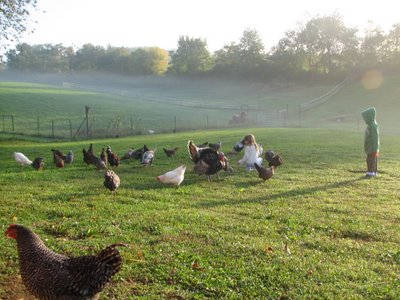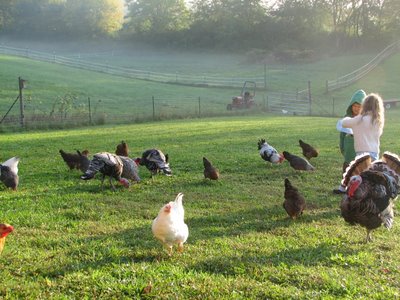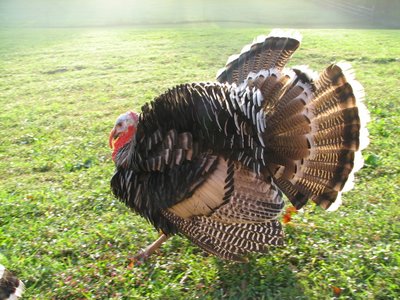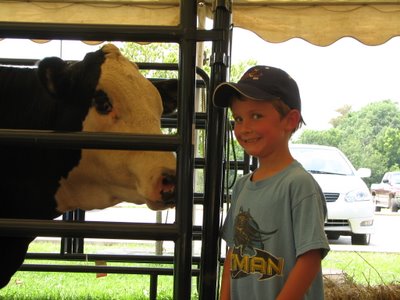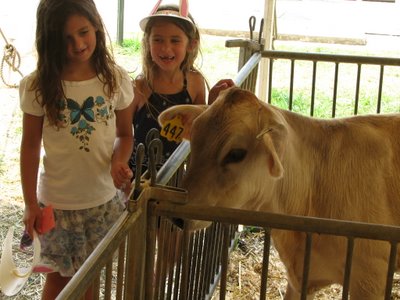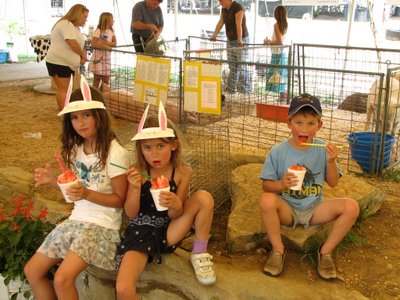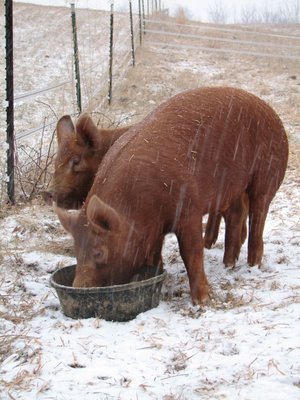
Tuesday, February 13, 2007
Snowy Morning
Got off to a slow start this morning. Snow started around 5am so I took my time getting ready for work to let everything settle on the roads. Since I was still at home when the sun was up I let out and fed the animals before I left. Normally Danielle takes care of the animals in the morning, but it was peaceful to feed the animals in the falling snow.


Saturday, January 27, 2007
Winter Finally Here
Well winter has finally arrived, and none too soon. After watching "An Inconvenient Truth" with the kids last week Sam was convinced that we would never have snow again. It was real windy and started snowing hard Thursday afternoon. The kids headed out the door just as soon as they saw that the snow was sticking. The kids did their best to get some sledding in, even though we barely had a dusting.
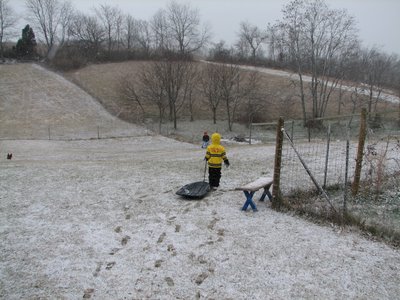

The snow did not seem to bother the goats any, they just went about their business as normal, but the pigs were happy to curl up inside their shelter and wait for the squall to blow over. Not more than an hour after these pictures were taken all the snow had melted and Sam was back waiting for winter.




The snow did not seem to bother the goats any, they just went about their business as normal, but the pigs were happy to curl up inside their shelter and wait for the squall to blow over. Not more than an hour after these pictures were taken all the snow had melted and Sam was back waiting for winter.


Monday, January 22, 2007
New Year -- New Fences
The addition of our pigs highlighted the need for some new paddocks. Although we have 5.25 acres only about half an acre was fenced in with goat fencing. I had previously tried to contain the goats with electric tape but their desire to be up by the barn and us was much greater than the deterrence factor of an electric shock. Having three goats, two pigs and thirty some chickens all on half an acre was definitely taking a toll on the pasture. Besides the over grazing, the rooting of the pigs and their enormous manure production was just too much for the area to handle. So the mild weather around the new year provided a good opportunity to fence in the upper pasture. Enclosing this field effectively doubled the area for the animals as well as enabling the goats to browse the hedge row.

I purchased two rolls of fencing for the upper pasture, but since I was able to tie into an existing line of field fencing in the hedge row I only used one. The other roll was used to fence in a long border with our neighbors properties. The kids helped me remove the electric tape and post connectors as well as driving the tractor with all the needed tools.
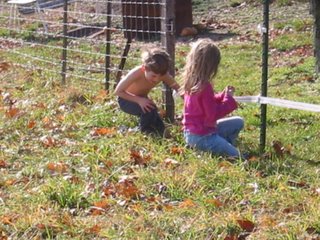


Finally, we used the recovered electric tape and some step in posts and a few hog panels to make a paddock for the pigs. The pigs are not nearly as agile as the goats and after getting shocked a few times the first day have been content to be in their quarter acre slice of heaven. Now their rooting and manure is being put to good use, prepping the area of pasture for spring plantings.
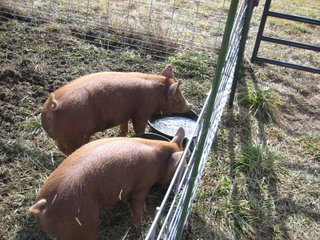
They sleep in a simple A-frame structure fabricated from a tarp and some scrap pallets. Another pallet A-frame provides shelter for our rent a stud goat buck Skeeter in the upper pasture.
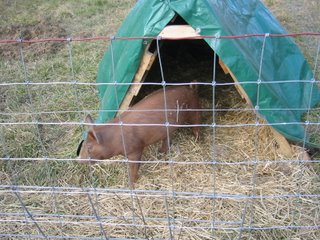

I purchased two rolls of fencing for the upper pasture, but since I was able to tie into an existing line of field fencing in the hedge row I only used one. The other roll was used to fence in a long border with our neighbors properties. The kids helped me remove the electric tape and post connectors as well as driving the tractor with all the needed tools.



Finally, we used the recovered electric tape and some step in posts and a few hog panels to make a paddock for the pigs. The pigs are not nearly as agile as the goats and after getting shocked a few times the first day have been content to be in their quarter acre slice of heaven. Now their rooting and manure is being put to good use, prepping the area of pasture for spring plantings.

They sleep in a simple A-frame structure fabricated from a tarp and some scrap pallets. Another pallet A-frame provides shelter for our rent a stud goat buck Skeeter in the upper pasture.

Thursday, December 28, 2006
Another thing I never thought I would do
We added two Tamworth pigs to our small hobby farm a few weeks ago. My son and I in particular were excited to raise some pigs since we are as he likes to put it "bacon buddies". I must say the pigs are quite cute and we all enjoy having them around. We all get a laugh out of watching them run around since they can not bend in the middle and thus have a particularly amusing running style. Don't worry I am not getting too attached to them and I will have no problem sending them off to the butcher when they have fattened up.

Now for those of you who think the title of this post refers to the mere owning of pigs you are very much mistaken. See we purchased two weanling male pigs that were approximately ten to twenty pounds each. No problems so far except that the person we purchased them from had yet to castrate them. My wife brought the pigs home a few days before we went on vacation. A week down in Disney followed by a week of my wife and kids at her mother's place in Alabama. Did I mention that we all caught a nasty cold down at Disney which I am just finally starting to get over. What all this means is that by the time we are ready and able to castrate the pigs they weigh in at about 60 lbs for the big guy and maybe 40 lbs for the runt. I will spare you the details of the castration, except to say it is surgery that I am performing on the pigs while my wife is trying to hold them still. Normally watching my petite wife try to wrestle a pig would be funny, but when I am trying not to cut her or myself with the scalpel, nor cause any undue harm to the pigs during the procedure it is quite stressful.

I am happy to say that the pigs seem to be healing nicely, and my wife and I now know that we can do some things we never would have thought about.

Now for those of you who think the title of this post refers to the mere owning of pigs you are very much mistaken. See we purchased two weanling male pigs that were approximately ten to twenty pounds each. No problems so far except that the person we purchased them from had yet to castrate them. My wife brought the pigs home a few days before we went on vacation. A week down in Disney followed by a week of my wife and kids at her mother's place in Alabama. Did I mention that we all caught a nasty cold down at Disney which I am just finally starting to get over. What all this means is that by the time we are ready and able to castrate the pigs they weigh in at about 60 lbs for the big guy and maybe 40 lbs for the runt. I will spare you the details of the castration, except to say it is surgery that I am performing on the pigs while my wife is trying to hold them still. Normally watching my petite wife try to wrestle a pig would be funny, but when I am trying not to cut her or myself with the scalpel, nor cause any undue harm to the pigs during the procedure it is quite stressful.

I am happy to say that the pigs seem to be healing nicely, and my wife and I now know that we can do some things we never would have thought about.
Sunday, December 10, 2006
Farm Truck
Besides a tractor a good old truck is probably the most indispensable tool to have on a farm. I had been looking for a truck for sometime and finally was able to find one last week that fit the bill. It is a 1986 Chevrolet Silverado diesel with over 200K miles on it. We now have something besides the wifes mini-van to cart hay, goats, pigs etc. around in.
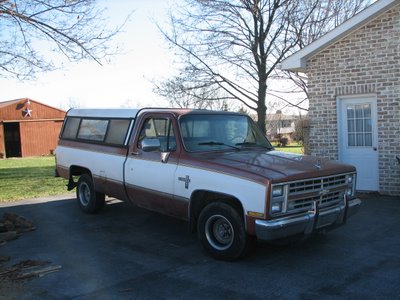

Saturday, December 02, 2006
Thanksgiving Turkey

As my wife is fond of saying, we started Thanksgiving dinner last Easter by setting 18 Narragansett turkey eggs into an incubator. From those 18 eggs we only had three turkeys make it to maturity one of which was white (not the proper coloring for a Naragansett).
 We augmented our flock with two birds from Springfield Farm to make sure that we would have a breading pair.
We augmented our flock with two birds from Springfield Farm to make sure that we would have a breading pair. All told we ended up with three Toms one Hen and the aforementioned white. In order to allow the bird to age appropriately and to avoid grossing out some house guests I processed one of the Toms and the white one the weekend before Thanksgiving. After plucking and cleaning our Tom weighed in at ten and a half pounds. The white went into the deep freezer and will be dinner sometime this winter.
 On Thanksgiving we also cooked a store bought thirteen pound bird, to ensure leftovers and placate my mother who was somewhat leery of eating our homegrown bird. While our bird was a few pounds smaller it was considerably taller (our turkey is on the left).
On Thanksgiving we also cooked a store bought thirteen pound bird, to ensure leftovers and placate my mother who was somewhat leery of eating our homegrown bird. While our bird was a few pounds smaller it was considerably taller (our turkey is on the left).All said and done the turkey was delicious and it was great that the potatoes and beans were also grown on our farm.

Tuesday, November 21, 2006
An Accidental Dinner
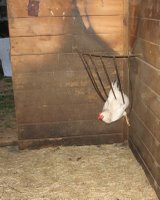 Our chickens like to go into the goat stall during the day to root around through the straw for food as well as to just hunker down out of the weather. Some had gotten in the habit of jumping up on-top of the corner hay feeder. This was not a problem when it was full of hay other than the fact that they tended to spill some of it, but one day the feeder was empty and one of our Delaware's managed to fall down into the feeder and get herself stuck. Not sure how long she was like this but upon removing her it was clear she could not walk. Danielle hoped that she was just in shock so she isolated her and gave her some food and a electrolyte solution.
Our chickens like to go into the goat stall during the day to root around through the straw for food as well as to just hunker down out of the weather. Some had gotten in the habit of jumping up on-top of the corner hay feeder. This was not a problem when it was full of hay other than the fact that they tended to spill some of it, but one day the feeder was empty and one of our Delaware's managed to fall down into the feeder and get herself stuck. Not sure how long she was like this but upon removing her it was clear she could not walk. Danielle hoped that she was just in shock so she isolated her and gave her some food and a electrolyte solution.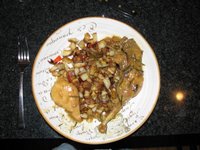 After a couple of days it was clear that she was not going to recover so I culled her. Not really wanting to take the time to pluck all her feathers I instead just skinned her. It was apparent when butchering her that she had broken her one leg and had a significant amount of internal injuries. It ended up that I was only able to salvage the two hind quarters and one breast. After letting the meat age for a few days in the refrigerator I made what turned out to be a delightful dinner -- if I do say so myself. I first browned the chicken on the stove top with some butter and onions. Then added some chicken stock to deglaze the pan and baked it with some fresh rosemary from the garden. Served over some farmstyle home fries made with our own red potatoes it was quite a treat.
After a couple of days it was clear that she was not going to recover so I culled her. Not really wanting to take the time to pluck all her feathers I instead just skinned her. It was apparent when butchering her that she had broken her one leg and had a significant amount of internal injuries. It ended up that I was only able to salvage the two hind quarters and one breast. After letting the meat age for a few days in the refrigerator I made what turned out to be a delightful dinner -- if I do say so myself. I first browned the chicken on the stove top with some butter and onions. Then added some chicken stock to deglaze the pan and baked it with some fresh rosemary from the garden. Served over some farmstyle home fries made with our own red potatoes it was quite a treat.We have since removed the corner feeders from all of our stalls, but this definitely seems like an example of making lemonade from lemons.
Friday, November 10, 2006
Our First Rifle(s)
Make no mistake this was a big transition for self proclaimed liberal easterners, the acquisition of our first firearm. Growing up in densely populated Northern New Jersey I never handled or fired a gun when I was a child. There really was just never the opportunity or reason to do so. Since moving to a farm in Western Maryland things have changed substantially. As just one example a few months after we moved in one of our dogs chased/cornered a groundhog into the goat stall of the barn. Now groundhogs are a real pest around here since they do a job on the fields with their tunneling, as well as their habit of digging into gardens and eating all of the good fruits and veggies. We realized that we wanted to dispatch it, but needed to ask our neighbor to come over with a rifle to take care of him.
So when my Dad mentioned that he had an old single-shot .22 rifle that he won in a poker game during college (whole other story there that we will not go into) I jumped at the chance to have it, "for the farm" as my dad put it. My folks still live in the same house I grew up in and thus the rifle had been sitting unused in the attic for more than 40 years.
When I brought the rifle into the house, we had a family discussion, ostensibly to talk about the responsibilities associated with having a firearm. We were talking and the kids were listening and interjecting and at one point I was somewhat sloppy in my choice of words and said something along the lines of "Since we now have a weapon in the house..." My 6 year old quickly interjected to correct me stating that we already have weapons "we have all these sharp knives ...". The obvious albeit sometimes overlooked fact that many of the tools we have around the house and farm can be used as weapons, and the fact that my children recognized this made me more comfortable that they understood what the rifle signified.
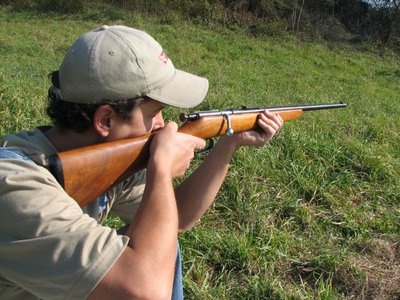
Since that was out of the way obviously the next thing was to see how well the rifle shot. After cleaning the barrel the kids and I went out to the back pasture where we would have a safe backstop, set up a makeshift target and tried out the rifle. While the rifle seemed to operate fine my shooting prowess needed a significant amount of work. The kids all tried it out, but since this is an adult sized rifle they were not able to hold it with proper form. Not wanting them to be discouraged or learn bad form I did what any unschooling homesteader would do, went out and bought them a youth-sized single shot rifle. So now in the space of a week or two we go from zero to two rifles in the house. The model I bought the kids is actually a matched pair, meaning it has a .22 rifle barrel and a 20 gauge shotgun barrel that are interchangeable so depending on how you want to count things maybe 2 rifles and a shotgun.


The new rifle fits the kids much better and was an instant hit with the girls. Sam however was getting frustrated since he was unable to site the rifle properly. For those of you unfamiliar with shooting a gun, when you use open or iron sites you need to focus on the end site and line it up in the slot of the rear site. To be honest if you are not used to doing this it takes a while to get used to and it helps to close your non-shooting eye. This is a lot to ask of a six year old and I wanted shooting to be something Sam enjoyed not something that made him feel insufficient. It is really tough always being the youngest. This lead to another trip to the sporting goods store and the purchase of a Red Dot scope. This is a non-magnifying rifle scope that superimposes a red dot on the target. All you have to do is look through the scope put the red dot where you want to shoot and squeeze the trigger. With this addition Sam is doing great and it felt great to me when he lit up with the re-newed self-confidence.

Not sure where we are going to go from here, but we have discussed hunting some rabbits since they are in season now, although Julia wanted to jump right to deer. I explained that we needed a much more powerful rifle for that and we would not be going deer hunting for a number of years. She took solace in the fact that if we got any rabbits she could sew their pelts into cool stuff.
So when my Dad mentioned that he had an old single-shot .22 rifle that he won in a poker game during college (whole other story there that we will not go into) I jumped at the chance to have it, "for the farm" as my dad put it. My folks still live in the same house I grew up in and thus the rifle had been sitting unused in the attic for more than 40 years.
When I brought the rifle into the house, we had a family discussion, ostensibly to talk about the responsibilities associated with having a firearm. We were talking and the kids were listening and interjecting and at one point I was somewhat sloppy in my choice of words and said something along the lines of "Since we now have a weapon in the house..." My 6 year old quickly interjected to correct me stating that we already have weapons "we have all these sharp knives ...". The obvious albeit sometimes overlooked fact that many of the tools we have around the house and farm can be used as weapons, and the fact that my children recognized this made me more comfortable that they understood what the rifle signified.

Since that was out of the way obviously the next thing was to see how well the rifle shot. After cleaning the barrel the kids and I went out to the back pasture where we would have a safe backstop, set up a makeshift target and tried out the rifle. While the rifle seemed to operate fine my shooting prowess needed a significant amount of work. The kids all tried it out, but since this is an adult sized rifle they were not able to hold it with proper form. Not wanting them to be discouraged or learn bad form I did what any unschooling homesteader would do, went out and bought them a youth-sized single shot rifle. So now in the space of a week or two we go from zero to two rifles in the house. The model I bought the kids is actually a matched pair, meaning it has a .22 rifle barrel and a 20 gauge shotgun barrel that are interchangeable so depending on how you want to count things maybe 2 rifles and a shotgun.


The new rifle fits the kids much better and was an instant hit with the girls. Sam however was getting frustrated since he was unable to site the rifle properly. For those of you unfamiliar with shooting a gun, when you use open or iron sites you need to focus on the end site and line it up in the slot of the rear site. To be honest if you are not used to doing this it takes a while to get used to and it helps to close your non-shooting eye. This is a lot to ask of a six year old and I wanted shooting to be something Sam enjoyed not something that made him feel insufficient. It is really tough always being the youngest. This lead to another trip to the sporting goods store and the purchase of a Red Dot scope. This is a non-magnifying rifle scope that superimposes a red dot on the target. All you have to do is look through the scope put the red dot where you want to shoot and squeeze the trigger. With this addition Sam is doing great and it felt great to me when he lit up with the re-newed self-confidence.

Not sure where we are going to go from here, but we have discussed hunting some rabbits since they are in season now, although Julia wanted to jump right to deer. I explained that we needed a much more powerful rifle for that and we would not be going deer hunting for a number of years. She took solace in the fact that if we got any rabbits she could sew their pelts into cool stuff.
Sunday, October 15, 2006
Last of the Tomatoes

We have had our first frosts the last couple nights. We were able to get some row covers over the lettuce and spinach, but there seemed no good way to protect the tomatoes. Here are the last of the San Marzano and Beefsteak tomatoes, in half bushel baskets my Mom was able to acquire for us. We are going to store them down in the cellar with the potatoes in hope that they will slowly ripen and extend our fresh tomato season.
Saturday, October 14, 2006
Filling the Hay Loft
 This morning Julia and I took the tractor and trailer up to the corn patch and harvested all of the remaining corn stalks. While this last planting of corn was a complete bust in terms of ear corn it did provide a fair amount of stalks. We cut down the stalks at the ground and bundled them with some twine into 6 large bales.
This morning Julia and I took the tractor and trailer up to the corn patch and harvested all of the remaining corn stalks. While this last planting of corn was a complete bust in terms of ear corn it did provide a fair amount of stalks. We cut down the stalks at the ground and bundled them with some twine into 6 large bales. After driving them back to the barn I threw them up into the loft and Emily helped arrange them. Latter in the day Danielle picked up 24 bales of straw which we also put up in the loft. As you can see we have quite a bit of supplies for the winter (from left to right it is corn, straw, hay). The corn will be used as a treat for the goats as well as feed for the pigs we are getting in a month.
After driving them back to the barn I threw them up into the loft and Emily helped arrange them. Latter in the day Danielle picked up 24 bales of straw which we also put up in the loft. As you can see we have quite a bit of supplies for the winter (from left to right it is corn, straw, hay). The corn will be used as a treat for the goats as well as feed for the pigs we are getting in a month.
Monday, October 09, 2006
Sunday, September 03, 2006
Culling, Processing, or as I like to call it a good old Chicken Slaughter
The chickens had finally fattened up so we decided to take advantage of the long Labor day weekend to slaughter, pick and pack our surplus cockerels. We are keeping one Welsummer and one Dorking rooster, but this left us with nineteen cockerels for meat. Trying to learn something from our earlier test run, we separated the cockerels from the rest of the flock Saturday, putting them in the extra stall in the barn. This allowed us to evaluate all of the cockerels and decide which two birds were the closest to their respective breed standards and thus would be kept on as our roosters.
It also made it much easier for me to grab the birds on the day of the slaughter since they were in a confined space. We normally use the extra stall to store hay for the goats, as well as to store other odds and ends. We covered up the hay with a tarp to keep the cockerels from getting into it, the whole point of separating them out is to clear their crop and stomach of food so that the eviscerating is less messy. This was not completely successful as they managed to still get into the hay and thus in the future we will want to put them in an empty stall.
We did not get started as early as I would have liked on Sunday, mostly due to the fact that I had to run out and pick up a knife to do the killing with. We do not have a boning knife and my pocket knife which I used on the test bird was not the best tool for the job. So after Sam and I ran out to the store and we all had breakfast I pulled killed and started processing the first three birds at around 10am.
Things were going along slow and steady, so slow in fact that my wife took sympathy on me and decided to help out with the picking. We worked out a system where I would kill three chickens at a time then bring them up to the patio where we would scald and pick them. The picked birds would go into the garage fridge to cool, and the process would continue. We did this until we had 9 or 10 birds cooling then we switched to eviscerating and packing. Again Danielle helped out -- I am only pointing this out since it was made clear to me early on that she did not want any part in the processing of the birds. I eviscerated and washed the chickens in the kitchen sink and Danielle did a final picking and cleaning of the birds then packed them into bags. We recently purchased a vacuum sealer (thanks to the kind support of our personal CSA) and she put the birds in these bags but did not seal them so that they could drain for a few days in the fridge before being sealed and transferred to the freezer.

So as not to be too boring you can figure out where it went from here, back out to kill and pluck the rest of the birds and then back inside to eviscerate and pack. When all was said and done including cleaning up the barn, patio and kitchen it was about 8:30 PM. A long day for sure but now we have a freezer full of chickens (well not full since my wife purchased a huge freezer but that is a different story) and we can look forward to pulling them out for dinner throughout the winter.
It also made it much easier for me to grab the birds on the day of the slaughter since they were in a confined space. We normally use the extra stall to store hay for the goats, as well as to store other odds and ends. We covered up the hay with a tarp to keep the cockerels from getting into it, the whole point of separating them out is to clear their crop and stomach of food so that the eviscerating is less messy. This was not completely successful as they managed to still get into the hay and thus in the future we will want to put them in an empty stall.
We did not get started as early as I would have liked on Sunday, mostly due to the fact that I had to run out and pick up a knife to do the killing with. We do not have a boning knife and my pocket knife which I used on the test bird was not the best tool for the job. So after Sam and I ran out to the store and we all had breakfast I pulled killed and started processing the first three birds at around 10am.
Things were going along slow and steady, so slow in fact that my wife took sympathy on me and decided to help out with the picking. We worked out a system where I would kill three chickens at a time then bring them up to the patio where we would scald and pick them. The picked birds would go into the garage fridge to cool, and the process would continue. We did this until we had 9 or 10 birds cooling then we switched to eviscerating and packing. Again Danielle helped out -- I am only pointing this out since it was made clear to me early on that she did not want any part in the processing of the birds. I eviscerated and washed the chickens in the kitchen sink and Danielle did a final picking and cleaning of the birds then packed them into bags. We recently purchased a vacuum sealer (thanks to the kind support of our personal CSA) and she put the birds in these bags but did not seal them so that they could drain for a few days in the fridge before being sealed and transferred to the freezer.

So as not to be too boring you can figure out where it went from here, back out to kill and pluck the rest of the birds and then back inside to eviscerate and pack. When all was said and done including cleaning up the barn, patio and kitchen it was about 8:30 PM. A long day for sure but now we have a freezer full of chickens (well not full since my wife purchased a huge freezer but that is a different story) and we can look forward to pulling them out for dinner throughout the winter.
Monday, August 07, 2006
Warning CARNAGE Below:
How we butchered our first Chicken
Since we purchased straight runs of Dorkings (25) and Welsummers (10) this past spring we were always aware that we would have on the order of 18 cockerels to deal with. We plan on keeping one of each species so that we can breed the chickens in the future instead of always ordering new chicks, but this still leaves us with quite a few chickens to dispose of. My wife specifically got multipurpose birds so that we could cull and eat the cockerels.
Well our new chicken coop that seemed huge when I first built it is starting to get crowded with the nearly 60 chickens which currently call it home. This along with the fact that the cockerels are nearly as big as our two and a half year old hens meant that we needed to start thinking about culling some of the cockerels. Since I have never processed a chicken before and I was going to do this by the book (i.e. no one was around to walk me through it) I decided to start small and just process one chicken. I isolated a Dorking cockerel in the morning and set him up with just water. I know you are supposed to do this overnight but I did not plan that far in advance. As it turned out I ended up butchering a different Dorking (one that got out of the chicken pen and into our yard). He was a real pain to catch so it seemed like as good a chicken as any to cull from our flock.
I built a killing cone from an old gallon milk container by cutting open the bottom and opening up the spout enough for the chickens head to poke through. With an old spackle bucket below to catch the blood I cut the chickens jugular and let it bleed out. I also de-brained it, which according to the books is supposed to make the process of plucking the feathers easier. After the chicken was done bleeding I scalded it for 30 seconds in hot water then the kids and I began plucking the bird. All and all I have to say that dealing with the feathers was the most time consuming part of the entire operation. While it was not hard to pull out the feathers, there just always seemed to be more of them.
Once the bird was as free of feathers as it was going to get it was time to eviscerate the chicken.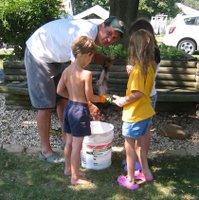 While this sounds daunting in the books, all you really are doing is cutting off the feet and head and removing the guts. Considering I did not really know what I was doing it all went smoothly. I was amazed by the size of the liver, it was by far the largest organ. I removed all the giblets and offal and disposed of them. In the future I will probably at least save the livers to make pate, but for my first run I just wanted to keep it simple. After washing off the bird and putting it in the fridge to cool I cleaned everything up and had a beer.
While this sounds daunting in the books, all you really are doing is cutting off the feet and head and removing the guts. Considering I did not really know what I was doing it all went smoothly. I was amazed by the size of the liver, it was by far the largest organ. I removed all the giblets and offal and disposed of them. In the future I will probably at least save the livers to make pate, but for my first run I just wanted to keep it simple. After washing off the bird and putting it in the fridge to cool I cleaned everything up and had a beer.
After relaxing for a while I fired up the grill and put some red potatoes on to roast. We made beer can chicken and grilled up some Gold Nugget tomatoes as well. Everyone except Sam tried some of the chicken.
We made beer can chicken and grilled up some Gold Nugget tomatoes as well. Everyone except Sam tried some of the chicken.
It had a lot of flavor but was a bit chewy. Not sure if this is the norm for free range birds or just cockerels. The neatest thing about dinner was that everything we ate came from our farm. The chicken, potatoes and tomatoes were all raised or grown on our farm. Even the rosemary and thyme came out of our kitchen garden. Danielle and I have been talking for some time about how great it would be to have an entire home grown meal, and I must say it was quite a treat.

The cockerel was on the small side so the rest of the flock has received a temporary reprieve, but in a couple weeks I will have to start processing the birds on a larger scale.
Well our new chicken coop that seemed huge when I first built it is starting to get crowded with the nearly 60 chickens which currently call it home. This along with the fact that the cockerels are nearly as big as our two and a half year old hens meant that we needed to start thinking about culling some of the cockerels. Since I have never processed a chicken before and I was going to do this by the book (i.e. no one was around to walk me through it) I decided to start small and just process one chicken. I isolated a Dorking cockerel in the morning and set him up with just water. I know you are supposed to do this overnight but I did not plan that far in advance. As it turned out I ended up butchering a different Dorking (one that got out of the chicken pen and into our yard). He was a real pain to catch so it seemed like as good a chicken as any to cull from our flock.

I built a killing cone from an old gallon milk container by cutting open the bottom and opening up the spout enough for the chickens head to poke through. With an old spackle bucket below to catch the blood I cut the chickens jugular and let it bleed out. I also de-brained it, which according to the books is supposed to make the process of plucking the feathers easier. After the chicken was done bleeding I scalded it for 30 seconds in hot water then the kids and I began plucking the bird. All and all I have to say that dealing with the feathers was the most time consuming part of the entire operation. While it was not hard to pull out the feathers, there just always seemed to be more of them.
Once the bird was as free of feathers as it was going to get it was time to eviscerate the chicken.
 While this sounds daunting in the books, all you really are doing is cutting off the feet and head and removing the guts. Considering I did not really know what I was doing it all went smoothly. I was amazed by the size of the liver, it was by far the largest organ. I removed all the giblets and offal and disposed of them. In the future I will probably at least save the livers to make pate, but for my first run I just wanted to keep it simple. After washing off the bird and putting it in the fridge to cool I cleaned everything up and had a beer.
While this sounds daunting in the books, all you really are doing is cutting off the feet and head and removing the guts. Considering I did not really know what I was doing it all went smoothly. I was amazed by the size of the liver, it was by far the largest organ. I removed all the giblets and offal and disposed of them. In the future I will probably at least save the livers to make pate, but for my first run I just wanted to keep it simple. After washing off the bird and putting it in the fridge to cool I cleaned everything up and had a beer. After relaxing for a while I fired up the grill and put some red potatoes on to roast.
 We made beer can chicken and grilled up some Gold Nugget tomatoes as well. Everyone except Sam tried some of the chicken.
We made beer can chicken and grilled up some Gold Nugget tomatoes as well. Everyone except Sam tried some of the chicken. It had a lot of flavor but was a bit chewy. Not sure if this is the norm for free range birds or just cockerels. The neatest thing about dinner was that everything we ate came from our farm. The chicken, potatoes and tomatoes were all raised or grown on our farm. Even the rosemary and thyme came out of our kitchen garden. Danielle and I have been talking for some time about how great it would be to have an entire home grown meal, and I must say it was quite a treat.

The cockerel was on the small side so the rest of the flock has received a temporary reprieve, but in a couple weeks I will have to start processing the birds on a larger scale.
Thursday, August 03, 2006
First Corn Harvest
 Well I have to admit with all of the problems I was having with the deer that I was considering not growing corn next year. Forget that! Last night we harvested some corn from our first planting and it had to be the best corn I ever tasted. Mind you I am extremely biased but my family seemed to enjoy it also. I originally picked five ears so that everyone could have a taste. That was not nearly sufficient so Julia and I went back out to the field to get some more. While we were out there she decided that we should pick a couple extra ears since she wanted some for lunch today. Julia and I ended up eating three ears each. I have to admit it made me really happy to have the corn go over so big.
Well I have to admit with all of the problems I was having with the deer that I was considering not growing corn next year. Forget that! Last night we harvested some corn from our first planting and it had to be the best corn I ever tasted. Mind you I am extremely biased but my family seemed to enjoy it also. I originally picked five ears so that everyone could have a taste. That was not nearly sufficient so Julia and I went back out to the field to get some more. While we were out there she decided that we should pick a couple extra ears since she wanted some for lunch today. Julia and I ended up eating three ears each. I have to admit it made me really happy to have the corn go over so big. 

Needless to say I will definitely be planting corn again next year.


Monday, July 31, 2006
Last of Potatoes Dug
Dug the last of the potatoes this weekend. All the foliage from the Yukon Golds had died back, so it seemed like time to dig them up. I dug the first row by hand with a pitch fork, just like I did all three rows of the Red Nordlands. Being that it was incredibly hot this weekend I needed to find a better way if was going to get them all done. Decided to try out the potato plow which I used to plow the trenches that the potatoes were planted in. I was originally concerned that the plow would damage the potatoes, hence the hand digging. I was surprised by how well the plow worked. It popped up most of the potatoes and completely loosened the ground so the rest were easy to uncover with my bare hands. Chalk this one up to being new to farming. From now on I will be plowing up the potatoes except for the times when I just want to grab a couple new potatoes out of the field.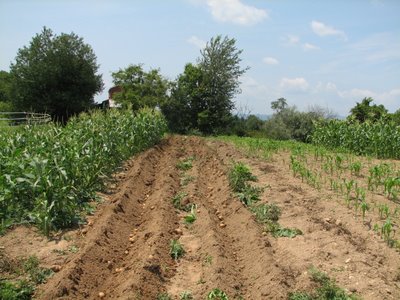

Friday, July 28, 2006
Fun at the Ag Fair
Tuesday, July 25, 2006
Cleaning Up My Deer Problem
As mentioned numerous times on this blog, the local deer population really enjoys my corn crop. 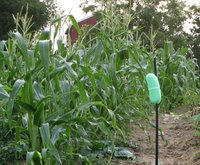 While I have started to get some corn from my first planting the size of the plants and consequently the size of the corn is quite small due to all the deer damage. Having finally gotten tired of it, and spurred on by the visit last weekend of an interested party (who supplied the Irish Spring) last night I assembled a soap barrier around my corn field. I sliced the soap into pieces, affixed them to bamboo stakes with zip ties and placed them approx. 10-15 feet apart in a perimeter around the corn field. While I am resigned to the fact that this will do little to help the first planting, I am hopeful that the latter corn plantings may do better if the soap reduces the deer grazing.
While I have started to get some corn from my first planting the size of the plants and consequently the size of the corn is quite small due to all the deer damage. Having finally gotten tired of it, and spurred on by the visit last weekend of an interested party (who supplied the Irish Spring) last night I assembled a soap barrier around my corn field. I sliced the soap into pieces, affixed them to bamboo stakes with zip ties and placed them approx. 10-15 feet apart in a perimeter around the corn field. While I am resigned to the fact that this will do little to help the first planting, I am hopeful that the latter corn plantings may do better if the soap reduces the deer grazing.

 While I have started to get some corn from my first planting the size of the plants and consequently the size of the corn is quite small due to all the deer damage. Having finally gotten tired of it, and spurred on by the visit last weekend of an interested party (who supplied the Irish Spring) last night I assembled a soap barrier around my corn field. I sliced the soap into pieces, affixed them to bamboo stakes with zip ties and placed them approx. 10-15 feet apart in a perimeter around the corn field. While I am resigned to the fact that this will do little to help the first planting, I am hopeful that the latter corn plantings may do better if the soap reduces the deer grazing.
While I have started to get some corn from my first planting the size of the plants and consequently the size of the corn is quite small due to all the deer damage. Having finally gotten tired of it, and spurred on by the visit last weekend of an interested party (who supplied the Irish Spring) last night I assembled a soap barrier around my corn field. I sliced the soap into pieces, affixed them to bamboo stakes with zip ties and placed them approx. 10-15 feet apart in a perimeter around the corn field. While I am resigned to the fact that this will do little to help the first planting, I am hopeful that the latter corn plantings may do better if the soap reduces the deer grazing.
Monday, July 17, 2006
Shortest Corn in the East!
No this is not some new dwarf corn variety. This white super sweet planted on May 7th should be 6 to 7 feet tall, but the deer have done a good job of stunting its growth. While never reaching full height it has started to silk out and form cobs. I guess we will just have to wait and see if we get any edible corn out of this first planting.
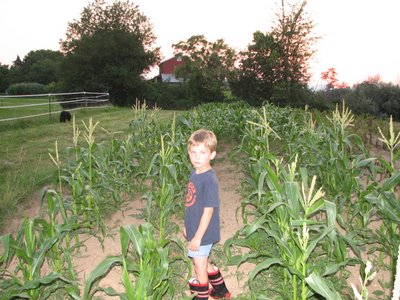

The second planting which went in on June 4th is doing noticeably better. It is already as tall as the first planting while being four weeks behind. My neighbors corn, not more than 100 yds away is tall and almost untouched by the deer. I talked with them this weekend and plan on picking up some Irish Spring soap to hang from posts around the outside of the corn field since it has seemed to work for them. Hopefully this will keep the deer browseing down to a minimum and allow the second and third planting to do better. Next year I will have the electric fence setup which will hopefully alleviate the deer problem.


The second planting which went in on June 4th is doing noticeably better. It is already as tall as the first planting while being four weeks behind. My neighbors corn, not more than 100 yds away is tall and almost untouched by the deer. I talked with them this weekend and plan on picking up some Irish Spring soap to hang from posts around the outside of the corn field since it has seemed to work for them. Hopefully this will keep the deer browseing down to a minimum and allow the second and third planting to do better. Next year I will have the electric fence setup which will hopefully alleviate the deer problem.
Subscribe to:
Posts (Atom)

